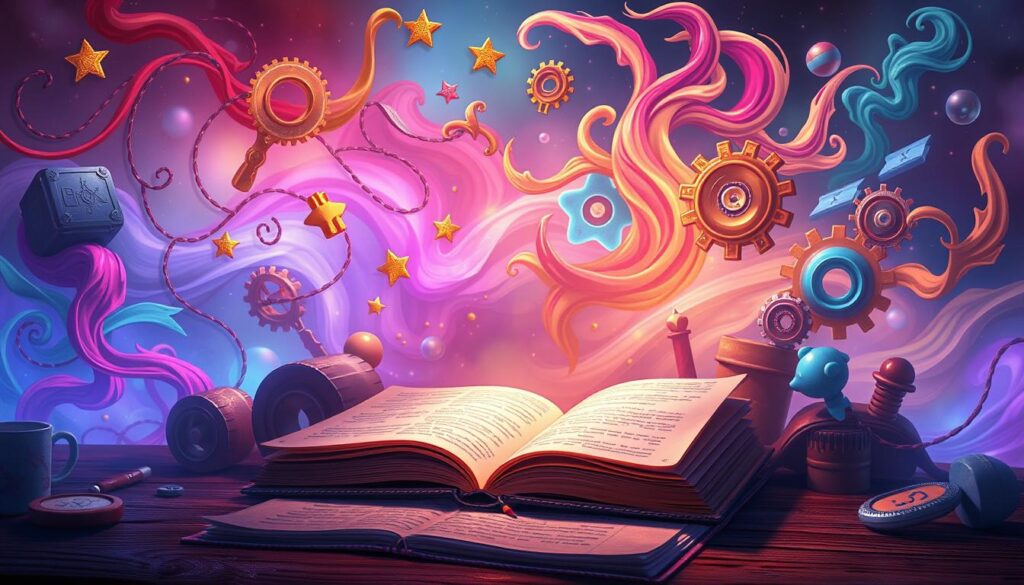“Creativity is intelligence having fun.” – Albert Einstein. This quote captures the essence of combining creativity with technology, especially in writing. Today, writers are embracing tools like ChatGPT to boost their storytelling. As technology advances, so does the art of storytelling, making it crucial to learn how to use ChatGPT effectively.
ChatGPT acts as a versatile writing assistant, capable of brainstorming ideas, creating dialogue, and aiding in editing. It offers two models: the free GPT 3.5, which is quicker but less sophisticated, and the more advanced GPT 4, available through ChatGPT Plus at $20 per month1. For those refining complex plots or detailed prose, ChatGPT Plus is invaluable. Casual users, however, will find the free model adequate for brainstorming or summarizing1.
This article will guide you through the journey of using ChatGPT for story writing. We’ll cover understanding its capabilities, setting up for writing, and exploring character development and plot crafting. We’ll also discuss finalizing your story before sharing it with others. With detailed guidelines and insights, you’ll be ready to unlock ChatGPT’s full potential in your writing.
Key Takeaways
- ChatGPT can significantly enhance storytelling by generating creative ideas and dialogue.
- The tool offers two models, with ChatGPT Plus providing advanced features for dedicated writers.
- It supports structured outputs, ensuring coherent and engaging narratives.
- Writers can utilize ChatGPT for brainstorming, drafting, and editing stories efficiently.
- Ethical use requires awareness of originality and potential plagiarism concerns.
Understanding ChatGPT’s Capabilities
https://www.youtube.com/watch?v=7tPcgziaoXM
ChatGPT is a cutting-edge AI writing tool that’s changing the game in storytelling. It uses natural language processing to help users in various writing tasks. Developed by OpenAI, this AI story generation tool aids in brainstorming and text creation, offering unique benefits for writers.
What is ChatGPT?
ChatGPT is a highly advanced AI model designed for tasks that require human-like interaction. It can generate text that’s coherent and relevant to the context by scanning billions of human-written pages. This process helps it determine the best continuations for prompts. Understanding ChatGPT means recognizing its ability to mimic patterns from the vast texts it was trained on, including fiction, non-fiction, and conversational data2.
How ChatGPT Generates Text
The text generation process in ChatGPT involves complex algorithms that analyze user input. It produces content that’s unique with each interaction by generating a ranked list of words along with their probabilities. The model’s temperature setting can adjust the randomness in word selection, allowing for both structured and diverse text outputs. For instance, a temperature of 0.8 leads to more varied essays, while a lower temperature may result in repetitive content3.
Benefits of Using ChatGPT for Writing
The advantages of using ChatGPT go beyond mere convenience. This AI-assisted writing tool helps overcome writer’s block, boosts productivity, and offers innovative ideas during the creative process. Writers find that ChatGPT significantly reduces drafting and editing time by suggesting alternative phrasings and improving narrative flow. Engaging with this technology shows how it can revolutionize the writing landscape, offering insights that traditional methods may not provide4.
Setting Up for Story Writing

To start with ChatGPT for story writing, a proper setup is crucial. First, users must create a ChatGPT account, available for free or with a paid plan for extra features. After registration, it’s vital to grasp the ChatGPT user interface. This includes features like inputting prompts, managing settings, and viewing generated content. Knowing the layout boosts productivity and enhances the storytelling experience.
Creating an Account
Setting up a ChatGPT account is straightforward. Visit the official website, enter your details, and decide between a free or paid plan. The paid option, ChatGPT Plus, offers more features, including access to the latest GPT-4 model.
Navigating the Interface
After setting up your account, you can explore the ChatGPT interface with ease. It has two main areas: the prompt input and the output display. Understanding these sections optimizes AI use, improving the quality of your stories.
Choosing the Right Settings
Customizing ChatGPT settings is key to a personalized experience. Users should pick prompts that match their writing style and adjust settings for tone and quality. Correctly configuring these settings leads to a tailored storytelling process, making it simpler to achieve your narrative goals.
Brainstorming Story Ideas
Writers often struggle with generating story ideas. Using ChatGPT for brainstorming is a fresh approach to overcome these challenges. By setting parameters like genre, character types, and themes, writers get personalized suggestions. These spark creativity and help craft compelling stories. ChatGPT aids in creating original ideas, offering guidance during writer’s block. This environment is perfect for exploring new concepts5.
Techniques for Generating Ideas
Asking specific questions, like “What should I write about?”, is an effective method. This helps ChatGPT provide more relevant ideas5. Writers might ask for help with character profiles or plot twists. ChatGPT also offers insights into world-building, suggesting creative ideas for geography, culture, and politics in fictional worlds5. This interaction is crucial for developing ideas and highlights the need for clear questions.
Using Prompts to Inspire Creativity
Writing prompts are a powerful tool for sparking creativity. They save time and streamline brainstorming, allowing ChatGPT to suggest interesting ideas quickly6. Using this AI tool can also boost productivity, making first drafts faster by providing structured outlines. It’s beneficial to keep notes of any interesting responses for future use.
While ChatGPT is a valuable brainstorming tool, writers must take responsibility for developing ideas. It’s important to use this tool patiently and creatively, guiding it to generate ideas that match the writer’s style. This collaboration can lead to innovative and enjoyable writing experiences567.
Structuring Your Story

Creating a solid foundation through understanding story structure basics is crucial for any writer. It’s vital to grasp the essential components of a storytelling framework to deepen the narrative. The structure includes key elements like exposition, rising action, climax, falling action, and resolution. These elements together form a compelling narrative flow.
Understanding Story Structure Basics
Grasping story structure basics helps writers maintain the pacing needed to keep readers engaged. This knowledge becomes even more powerful when using tools like ChatGPT for outlining. For example, MK Swanson found that ChatGPT greatly enhanced their creativity and efficiency in creating novel outlines8. Through dialogue with the AI, writers can craft outlines using various methods, including the plot clock or Snowflake method8.
The Importance of a Strong Outline
Creating a detailed outline is crucial as it acts as a roadmap for the writing journey. It guides the author through the story’s progression. With AI’s help, writers are seeing significant growth in their submissions across creative industries9. ChatGPT can generate outlines for classic works like “Pride and Prejudice” and assist in creating novel summaries and blurbs8
However, writers must be mindful of AI-generated content’s limitations. While these tools offer many ideas, they often lack originality and can lead to plagiarism9. Crafting effective prompts is key to guiding AI in creating coherent plots and character arcs. This highlights the importance of a solid story outline in the creative process10.
Developing Characters
Character development is crucial in storytelling, as it engages readers and makes stories relatable. Writers must understand how to define character roles to create protagonists, antagonists, and supporting characters. Each character has a specific purpose in the story. ChatGPT helps writers explore prompts to define roles, ensuring each character adds something unique to the narrative.
Defining Character Roles
Defining roles requires considering how each character fits into the story’s context. ChatGPT is a powerful tool for this, helping writers craft clear characteristics and roles that connect with audiences. This process enhances writing character history, leading to memorable character development that guides the storyline11.
Creating Backstories
Rich character backstories create a deeper emotional connection between characters and readers. Writers can use ChatGPT to create meaningful Character backstories based on motivations, origins, and relationships. This approach allows for detailed character profiles, enriching the narrative12 and saving time on brainstorming11.
Utilizing ChatGPT for Character Dialogue
Character dialogue writing can be challenging, especially in creating realistic interactions. ChatGPT assists in crafting dialogue that mirrors character personalities and conflicts. It offers various prompts for character interactions, making crafting dialogue with AI a valuable resource for authentic character development13.
Crafting the Story’s Setting

Creating an immersive story setting requires vivid descriptions and well-developed locations. A compelling story setting description can transport readers into a different world. It makes them feel the atmosphere and emotions of the narrative. Writers can engage their audience by painting vivid images of landscapes, cultures, and environments within their stories.
Describing Locations
To bring a location to life, writers should incorporate sensory details. These evoke sights, sounds, and smells. ChatGPT assists in generating creative descriptions based on user prompts, helping to flesh out unique aspects of locations. Writers should aim for specific details such as weather, architecture, and local flora. These details contribute significantly to the authenticity of their setting and enhance readers’ understanding.
Building a World with ChatGPT
Writers can use ChatGPT to brainstorm and develop complex fictional worlds. These worlds encompass various elements like geography, culture, and society. Before beginning, a well-defined synopsis guides prompts when interacting with ChatGPT. This ensures the generated content stays aligned with the writer’s vision.
Crafting an outline is also essential for maintaining the narrative arc. It facilitates the development of intricate creating fictional worlds while maximizing the tool’s potential. By leveraging ChatGPT’s capabilities, writers enhance their ability to articulate vivid settings. These settings draw readers deeper into the story1415.
Writing a Compelling Plot

Plot development is key in storytelling, drawing readers in with engaging elements. It involves using character arcs, themes, and pacing strategically. Understanding conflict is crucial as it drives character growth and keeps the story suspenseful.
Elements of Engaging Storylines
Every compelling plot balances conflict and resolution, making readers care about the characters. Creating plot twists is essential to keep the audience guessing and intrigued. For instance, ChatGPT can help brainstorm and refine story ideas, like a necromancer with undead lovers, adding depth to the narrative16.
AI tools like ChatGPT can spark creativity while respecting the author’s vision. This shows how AI can boost the writing process without losing the human touch.
Plot Twists and Conflict Generation
Tools like ChatGPT are great for introducing unexpected plot twists that surprise and elevate the drama. By trying out different storylines, writers can explore various conflicts. For example, an author used ChatGPT to write a 7,500-word story in just an hour17.
With structured prompts, the AI can create focused content efficiently. However, it’s important to remember that while AI provides a solid base, human touch is needed to ensure quality and depth in the story16.
ChatGPT is not just for generating ideas but also for adding complex scenarios to stories. It can suggest twists that delve into themes like loyalty through creative scenarios, such as memory loss or parallel worlds18. This integration of AI can enrich the plot with new perspectives and ideas, leading to impactful and thought-provoking stories.
Using ChatGPT for Writing Assistance

ChatGPT offers a creative and productive way to enhance your storytelling journey. It can act as a collaborative writing partner, helping generate ideas and expand narratives. Drafting stories with ChatGPT makes writing more fluid, automating the initial brainstorming process. This leads to faster writing sessions.
Trying out different prompts can result in unique and interesting outcomes. However, ChatGPT might not always follow the prompt exactly19. Users find it easy to input requests, prompting the AI to create content tailored to their needs.
Drafting with ChatGPT
ChatGPT’s ability to remember information enhances the drafting experience. It can store about 3,000 words worth of data, tracking and retaining context throughout the writing process19. By asking ChatGPT to portray different personas, like a novelist or a historical figure, you can get varied and engaging responses.
Writers can also ask ChatGPT to write in specific styles. Whether it’s an academic essay or a persuasive article, you can achieve tailored results that match your intent.
Editing and Revising with AI Support
Editing and revising are key steps in the writing process, and ChatGPT excels in these areas. When asked to revise previous work, the AI can generate updated versions based on user requests. It’s noted that ChatGPT is useful for adding detail and revising story drafts20.
However, it can sometimes produce predictable and bland writing20. To get more dynamic results, breaking requests into smaller chunks is advisable. Remember, ChatGPT may not provide accurate information for complex analysis or difficult-to-verify facts. It’s crucial to use AI editing tools alongside your own knowledge.
Enhancing Descriptions and Imagery

Vivid imagery is crucial for engaging storytelling. It stirs real emotions and lets readers see scenes and connect with characters. ChatGPT helps writers add sensory details that bring sights, sounds, and tastes to life. This tool is key in crafting emotional stories with rich imagery and layered descriptions.
More writers are seeing the value of AI in improving their craft. This is evident in the growing recognition of large language models (LLMs) in the industry21.
Improving Sensory Details
ChatGPT excels at creating descriptions that enhance sensory elements. By focusing on colors, sounds, and textures, writers craft unforgettable scenes. This method not only makes the text richer but also engages the reader’s senses, offering a more immersive experience.
Using prompts, writers can achieve clarity and conciseness. This significantly impacts how readers experience the story world21.
Creating Emotional Depth
Emotional depth is vital for impactful stories. ChatGPT aids in crafting dialogues and conflicts that touch the audience. Through continuous feedback, writers can refine their work, ensuring the emotional journey is compelling.
ChatGPT’s editing capabilities help maintain a consistent tone and originality. This aligns with the writer’s vision21. Thus, emotional storytelling and effective editing empower writers to create profound experiences and connect deeply with readers.
Finalizing the Story

Before sharing a story, proofreading and formatting are key steps. These processes ensure the work is polished and ready for an audience. AI-assisted proofreading can catch grammatical errors and awkward phrasing, making the story flow better. Proper formatting is also crucial, as it meets publishing standards and appeals to readers.
Proofreading and Formatting
AI tools have revolutionized the proofreading process in writing. Authors can use ChatGPT to quickly review their text, making necessary corrections and suggestions. This software identifies typos and punctuation errors that might be missed by the writer. By using AI for formatting, writers maintain consistency in margins, fonts, and headings, giving the manuscript a professional look.
This approach not only saves time but also boosts efficiency. It allows writers to concentrate on the creative aspects of their work. In competitive markets, a well-formatted manuscript is essential for standing out.
Resolving Loose Ends
A well-crafted narrative requires a satisfying conclusion, where all plot threads and character arcs are resolved. ChatGPT helps writers tie up loose ends, ensuring consistency in the storyline. It analyzes character development and plot paths to identify any discrepancies that could detract from the reader’s experience.
Creating a fulfilling conclusion captivates the audience, leaving them with a sense of satisfaction. Using such tools enhances the storytelling process, making the final product more engaging and coherent.
Sharing Your Story

After crafting a compelling narrative, it’s vital to explore various publishing avenues. Writers can opt for self-publishing or traditional publishing, depending on their objectives and target audience. Platforms like Amazon Kindle Direct Publishing and Wattpad offer straightforward paths for writers to share their work. Authors also have the option to submit to literary magazines, blogs, and social media, broadening their reach to diverse readers.
Platforms for Publishing
Each publishing platform caters to different readerships. Wattpad, for instance, attracts a younger audience and encourages community interaction through comments and ratings. On the other hand, traditional publishing houses, though less accessible, hold a strong reputation in the literary sphere. Writers must weigh their options carefully to align with their unique voice and style.
Engaging with Readers and Feedback
Engaging with readers is a pivotal part of the storytelling journey. Authors can collect feedback through social media, online forums, or by enabling comments on their blog posts. This dialogue helps writers understand what resonates with their audience, guiding their future work. By embracing reader feedback and actively engaging with their audience, authors can refine their craft and create stories that resonate on a deeper level.
Ethical Considerations of Using AI

The integration of AI in writing raises significant ethical concerns for authors. It’s crucial to balance the use of AI tools, like ChatGPT, with maintaining originality in writing. Ethical AI practices must be integrated into the creative process to prevent plagiarism and preserve personal voice. Most instructors view submitting unedited AI-generated work as academic misconduct22. With students advancing from grade school to college, the need for responsible AI use in assignments grows22.
Originality and Plagiarism Concerns
Authors must safeguard their unique style when using AI for help. Generative AI can aid in idea generation, narrowing topics, and drafting22. However, it’s essential to avoid relying solely on AI. AI-generated content may lack the creativity and nuance that humans bring23. Writers should use ChatGPT to organize thoughts and identify feedback overlaps, not to replace their insights. Fact-checking is also crucial, especially in historical fiction where accuracy is paramount23.
Best Practices for Ethical AI Use
To uphold *AI ethics*, writers must engage in Ethical AI practices. They should understand their responsibilities when using AI technologies. It’s important to recognize that students are accountable for AI errors22. As students interact with generative AI, discussing its use and setting clear boundaries helps them understand acceptable academic writing practices22. By following these guidelines, authors can leverage AI’s benefits without compromising their integrity. ChatGPT should enhance creativity, not diminish it.
Continuing Your Writing Journey
As writers advance, learning from feedback is crucial. They can refine their craft by embracing constructive criticism. This process involves incorporating valuable suggestions to boost their storytelling skills. In today’s digital age, tools like ChatGPT play a significant role in this learning journey. Users often report a significant improvement in writing efficiency and creativity.
One author, for example, has been using ChatGPT for a couple of months. They find it invaluable for generating content when they’re stuck. It helps expand simple ideas into more detailed narratives24.
ChatGPT also excels in summarizing and simplifying complex texts. This helps writers clarify their thoughts and present ideas more effectively. It enhances both analytical and creative aspects of writing, offering tailored suggestions25.
The journey of developing as a writer goes beyond just receiving feedback. It involves actively applying lessons to future projects. Collaborating with AI tools leads to a more dynamic writing practice. Writers blend their unique voice with AI-generated insights, enhancing originality and quality2426.
Effective use of feedback, whether from peers or AI, empowers authors to refine their skills. This collaborative approach positions writers for ongoing improvement and success. It allows them to navigate the ever-changing world of storytelling with confidence26.
FAQ
What is ChatGPT?
How does ChatGPT help with story writing?
Do I need to pay to use ChatGPT?
How can I maximize my use of ChatGPT?
What techniques can I use to generate story ideas with ChatGPT?
How can I develop characters using ChatGPT?
Can ChatGPT help with proofreading and editing my writing?
What should I consider when finishing my story?
Are there ethical considerations when using AI like ChatGPT for writing?
How can feedback impact my writing journey?
Source Links
- How to Write a Book in ChatGPT: My Complete Process
- How to Get ChatGPT to Write Better Fiction
- What Is ChatGPT Doing … and Why Does It Work?
- Using ChatGPT to Write the Short Book: Sharing the Journey – Sailing Sweet Ruca
- How to Use ChatGPT for Storytelling | StoryFlint
- From Story Idea to Outline Using ChatGPT
- Writing My First Book, Hoping to Find Out How ChatGPT Can Help
- Outline Your Novel with ChatGPT – Jamie Morris Writing Coach
- Being a Better Writer: How To Use AI Like ChatGPT To Write Your Story
- How to Write a Story in ChatGPT – Prompt Engineering
- Unlocking the Power of ChatGPT for Character Development: A Guide for Writers
- How to Use ChatGPT to Create a Complete Character Profile
- The Art of Fiction Writing With ChatGPT
- How to Write a Story with ChatGPT
- ChatGPT for Novel Writing: Step-by-Step Instructions
- How to Write a Novel With ChatGPT: My 6 Step Process
- Writing a story together with ChatGPT
- Use This Simple Story Plotting Method with ChatGPT
- How to… use ChatGPT to boost your writing
- ChatGPT for Creative Writing – the Good and the Bad
- How to Use ChatGPT to Edit Your Writing – Intellectual Lead
- Ethical use of AI in writing assignments
- Mini-Series: Ethical Ways Authors Can Use ChatGPT When Editing | She Writes
- My Secret Sauce of Using ChatGPT (as a Medium Writer)
- Writing with ChatGPT – Write of Passage
- I Asked ChatGPT To Write A Personal Story — Here’s How It Went







